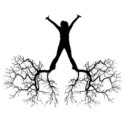
This activity is a lovely embodiment activity using the whole body.
Practise the different actions (the ones in italic) with your child.
When rolling them over, guide their head and ensure that they do not fall on to their face.
Once upon a time, there was a big strong old tree (your child stands as a tree). It lived in a forest, near a river. The tree would sway in the wind, but it had big strong roots. The birds would nest in its branches. Foxes and rabbits would build their homes around the base of the trunk. Squirrels would hibernate in the tree.
However, one day a woodcutter (you or another child) decided to chop the tree down to allow a younger tree to grow. So she (he) chopped the tree down (the child lies down on the floor and pretends to be a log). The woodcutter planted a new tree to replace the fallen tree. (woodcutter acts out planting a tree)

The woodcutter decided to have the log turned into a boat. So she (he) rolled the log to the river (the woodcutter gently and carefully rolls the log child over). The log floated down the river, (the woodcutter child now takes the role of the river and rolls the log). Unfortunately the log got stuck in some mud and reeds. The river tried to free the log. (the log child resists being moved). The river pushed with all its might, but was unable to free the log. Luckily the woodcutter saw that the log was stuck and raced to the river. She (he) pushed the log and managed to free it. (Woodcutter gently rolls the log child over.)
The log floated freely again down the river until it came to the boat makers. There the boat makers turned the log into a boat. The woodcutter was very pleased with the strong boat and climbed into it. (You and your child sit one behind each other and move forward together.) The woodcutter and the boat set sail on to the open seas and had many adventures together and lived happily ever after.
The benefits of this activity:
Reference:
Murray (nee Compton), S. (1997) Stories used therapeutically with children in educational settings. In Dwivedi, K. N. (ed) (1997) The Therapeutic Use of Stories, London: Routledge.